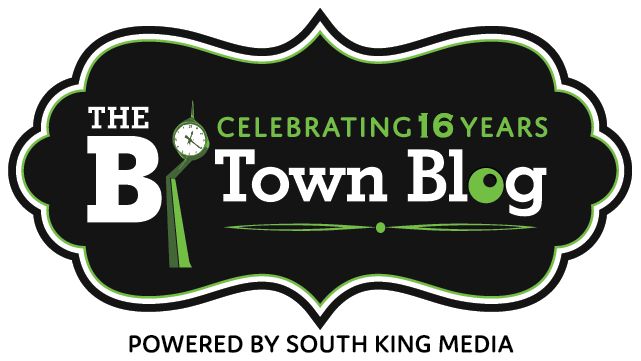Photos courtesy Nancy Tosta
On Tuesday night, Nov. 1, the Port of Seattle held a Community Meeting and Open House on its proposed Flight Corridor Safety Program, which is intended to remove around 3,000 trees at and around Sea-Tac Airport. Well over 100 people attended the event, which was held at Bow Lake Elementary School in SeaTac. In addition to the overflowing crowd of concerned citizens, Port Commissioners present included Tom Albro, John Creighton, Courtney Gregoire and Fred Felleman. The port had various display stations with details about the project, its connection with FAA regulations, as well as the intention to plant new trees and shrubs. Port representatives were at each display, answering questions from interested – and often passionate – attendees. A public comment section allowed residents to speak their minds, oftentimes with passion. According to Burien Councilmember Nancy Tosta:There were approximately 50 people offering comments (a couple hundred attending). Concerns were raised about noise, cutting trees on private property with lack of compensation, possibilities for topping rather than cutting trees down, mitigation plans that result in planting trees in other areas. Port Commissioners said they understand there is a lack of trust, ever since 3rd runway decision. They said there would be a transcript and answers to questions on their website. Debi Wagner and Larry Cripe were there through the meeting as well, as was Tina Orwell. I asked that Commissioners provide leadership in the region by recognizing the need for and working towards a second international airport.The program plans to roll out this program in three phases based on location, as follows:
- 2016 – Phase 1: Port properties (estimated 1,200 trees)
- 2017 – Phase 2: Publicly-owned properties (est. 1,400 with 1,200 on WSDOT property, many for future Hwy 509)
- 2018 – Phase 3: Residential properties (est. 180), commercial properties (est. 200)
- 1,200 trees on Port property
- 1,400 on publicly owned or commercial properties (about 1,200 on Washington State Department of Transportation property, many on land set aside for future Hwy 509 expansion)
- An estimated 180 trees on residential properties. Trees on residential properties will not be affected until 2018. Each resident will be contacted and offered a number of alternatives to choose from to best meet their needs.
 For more information and Frequently Asked Questions on the program, visit the project webpage here or visit www.portseattle.org/safecorridor.
“Thanks to the Port for holding the meeting,” Burien Councilmember Nancy Tosta said. “Port says FAA requires tree removal in the name of safety, but most residents are skeptical and believe it is part of an ongoing pattern of airport expansion that degrades neighborhoods. Tell the Port your thoughts!”
If you have questions or thoughts about this program, you are encouraged to email the Port at safecorridor@portseattle.org.]]>
For more information and Frequently Asked Questions on the program, visit the project webpage here or visit www.portseattle.org/safecorridor.
“Thanks to the Port for holding the meeting,” Burien Councilmember Nancy Tosta said. “Port says FAA requires tree removal in the name of safety, but most residents are skeptical and believe it is part of an ongoing pattern of airport expansion that degrades neighborhoods. Tell the Port your thoughts!”
If you have questions or thoughts about this program, you are encouraged to email the Port at safecorridor@portseattle.org.]]>




PSRC has surveyed areas in the state in search of an alternate site. What they found is that most airports have encroachment or sensitive land uses or critical areas that don’t allow them to expand and supplement or replace constrained Sea-Tac. I find it astounding that the laws for growth management and zoning, the same ones the Port is using to justify removing trees and lakes, moving streams, filling wetlands, closing schools and mowing down homes are the same ones not allowing expansion elsewhere because of these. Airports are not compatible with trees, birds, water bodies, homes schools, etc., but Sea-Tac has been expanding in the midst of this for 50 years. The law was meant to keep these areas clear, not bulldoze them down after the fact. If it can happen here, it surely can happen elsewhere. I am also surprised there isnt more regional outrage over the expansion plans that will double climate emissions to nearly 10 million metric tons per year and involve further natural habitat loss, salmon impacts, more noise, jet exhaust fumes and traffic congestion devastating a very large and heavily populated area.
This is more about increasing airport capacity, enabling more frequent flights, and allowing the Port to push more planes quicker through our airspace instead of addressing safety.
NEXTGEN is the program that allows this:
https://www.thebalance.com/nextgen-in-a-nutshell-282561
And in order to do this, these trees have to go:
https://www.faa.gov/nextgen/snapshots/airport/?locationId=45
So we will can look foreward to more of this:
http://jonlehman.synology.me:8666/BtownBlog/2016/10/03/burien-residents-form-quiet-skies-coalition-to-fight-increased-airplane-noise/
And jets going by every 30 seconds causing more pollution and negative impacts:
http://www.cbsnews.com/news/faa-new-air-traffic-control-system-nextgen-causing-major-noise-pollution/